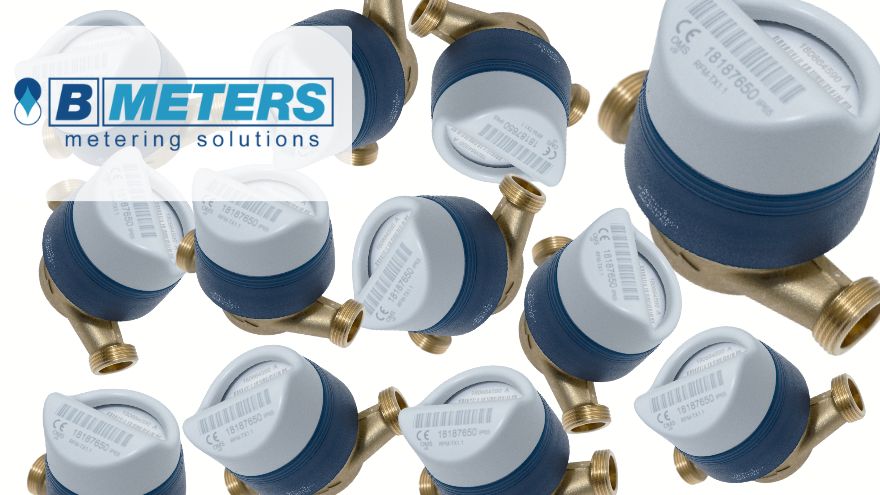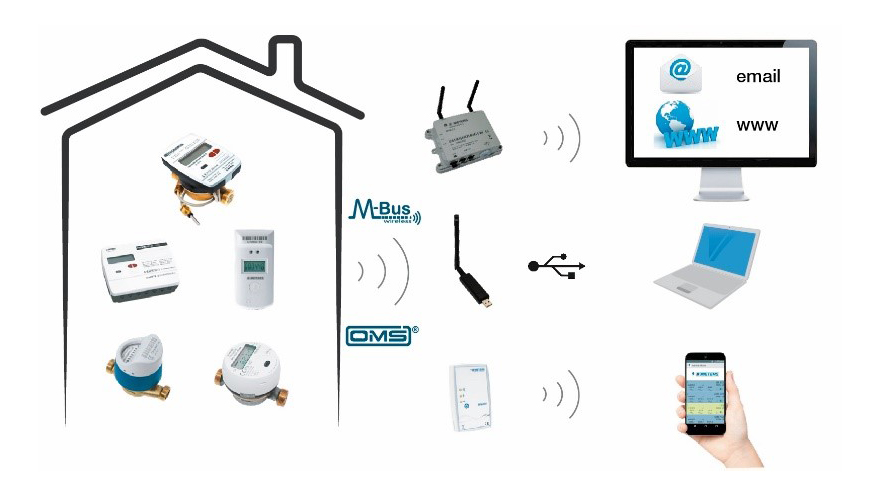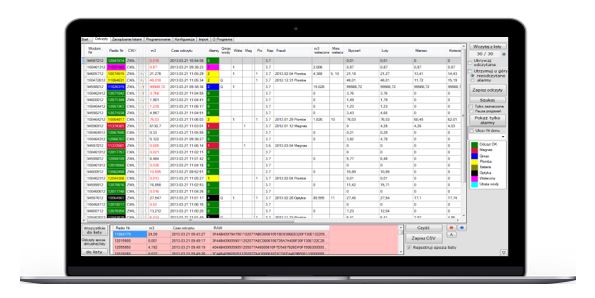Tax collectors knocking on doors is a gradually disappearing phenomenon thanks to the increasingly common remote readings of measuring devices. This is not only convenient and time-saving, but also safe, because fraudsters impersonate gas or energy company employees. What are the latest developments in the field of radio energy consumption measurement?

From this article you will learn:
- indication of which devices can be read remotely,
- what are the benefits of remote reading,
- what reading options are available.
Bmeters has been researching, developing and constantly improving solutions in the field of remote reading and utility billing for years. For maximum user convenience , all Bmeters devices equipped with radio modules are fully compatible with each other and can be read independently and conveniently using one collector set. The latest system of this type is called Hydrolink .
Purpose and elements of the Hydrolink system
Remote reading of water meters, heat meters and heating cost allocators is mainly used in multi-unit buildings. The integrated Hydrolink system includes:
- Bmeters GSD8-RFM water meters , Bmeters GSD8-I water meters , Bmeters GMDM-I water meters and Bmeters WDE-K50 water meters, adapted for mounting modules with remote reading function, and Hydrodigit water meter, equipped with an internal Wireless MBUS radio module as standard or, on request, LoRAWAN standard transmission,
- heat meters:
- mechanical heat meters Bmeters Hydrocal-M4 Radio and Bmeters Hydrosplit-M3 heat meters ,
- ultrasonic Hydrosonis ULC T230 and T330 and Hydrosonis M3,
- HydroClima 2 heating cost allocators.
Check out measuring devices at the Onninen wholesaler
Basic advantages of the Hydrolink system:
- reading of various devices with one, intuitive collector set,
- short reading time (without the need to enter the premises) and elimination of the need to make separate appointments with tenants who are absent during the reading,
- elimination of human error when reading readings (especially in hard-to-reach places),
- possibility of expanding the system with data concentrators enabling transmission via the Internet or GSM/LTE infrastructure,
- messages about abnormal conditions (wide list of alarms),
- history of readings and the ability to analyze water or heat consumption in a given period on a computer,
- possibility of independent configuration and operation of devices.
Hydrolink system architecture
Depending on user requirements, there are three main structures of the integrated Hydrolink remote reading system:
-
 Walk-by (collector reading) – devices equipped with radio modules are read directly by a collector set within the radio transmission range of these devices (e.g. from outside the building). Reading using a netbook, tablet or smartphone with dedicated software.
Walk-by (collector reading) – devices equipped with radio modules are read directly by a collector set within the radio transmission range of these devices (e.g. from outside the building). Reading using a netbook, tablet or smartphone with dedicated software. - Walk-by using repeaters – a walk-by system in which the radio signal from meters is extended using stationary devices over longer distances. Connecting repeaters into groups allows you to create a network and transmit the signal over longer distances.
- Stationary system with reading via the Internet - a fully remote system based on interoperating concentrators that receive, store and transmit data from end devices. Access to this data is possible in several ways: via the Internet from reading programs, on a dedicated FTP server or a specified e-mail address. Concentrators can transmit data using the GSM/LTE network infrastructure or Wi-Fi/LAN networks.
Technical data of the Hydrolink system
- operating frequency: 868 MHz;
- power supply for radio modules for water meters: lithium battery, service life 10 years + one year reserve, radio modules in heat meters powered by the heat meter battery, in the case of heating cost allocators, battery life up to 15 years;
- range: maximum 350 m in an open area without obstacles in the signal path, and for the LoRAWAN standard 10 km+,
- support for transmission standards: WMBUS OMS, LoRAWAN and planned implementation of NB-IoT technology.
Data transmitted via radio
Water meters - consumption in cubic meters (accurate to 1 liter), history of the last 12 months of readings, information about tampering attempts (applying a magnet, dismantling the module, reverse and maximum flow, no increase in readings, continuous flow, low battery level);
Heat meters - current heat and cold consumption, history of the last 12 months of heat and cold readings, total flow, instantaneous power, supply and return temperatures;
Heating cost allocators - units for the current and 9 previous billing periods, average ambient temperature for the current and previous billing period, 12 last months of unit indications and avg. ambient temperature. Maximum temperature with the date of occurrence, average radiator temperatures, temperature statistics - registration of the allocator operating time in various temperature ranges.
Reading software
 Thanks to Bmeters' programs, you can read the media yourself, configure the devices and settle all costs based on the data obtained. All programs work together and are easy to use. Thanks to this, the metering and billing system ensures convenience, self-sufficiency and control over the managed property.
Thanks to Bmeters' programs, you can read the media yourself, configure the devices and settle all costs based on the data obtained. All programs work together and are easy to use. Thanks to this, the metering and billing system ensures convenience, self-sufficiency and control over the managed property.
Open metering system (OMS)
Both the Hydrolink remote reading system and the devices operating in it are compatible with the OMS (Open Metering System) standard. In practice, this means that devices operating in this standard communicate in the same "language" regardless of the manufacturer. It is possible to read them with one receiver or connect them to one data reading system via the Internet. Measuring devices based on the OMS standard have been developed and created with the future directions of development of European networks of smart energy, water, heat and gas meters in mind. This means that they are an investment for many years.